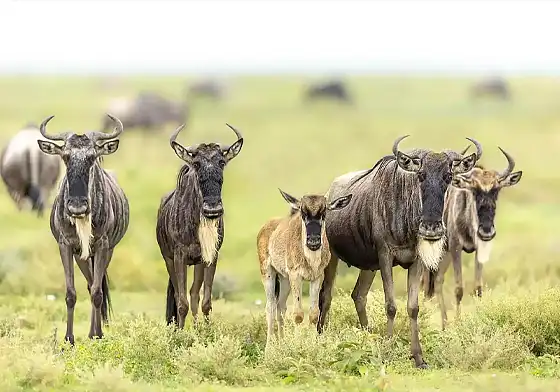Calvin Season Migration
- Home
- Tanzania Safari
- Calvin Season Migration
Calving Season Migration in Tanzania: Witness the Miracle of New Life in the Wild
The African savannah is no stranger to jaw-dropping spectacles—but few events stir the soul quite like the calving season during Tanzania’s Great Migration. Imagine vast open plains filled with mother wildebeest huddling protectively around their newborns, the air thick with anticipation, and predators lurking nearby in what becomes one of nature’s most intense survival dramas.
If you thought the Great Migration was all about river crossings and stampedes—think again. Calving season, which takes place in the southern Serengeti and Ndutu region, is a lesser-known yet unforgettable chapter of the migration story. And honestly? It’s one of the best times to go on safari if you’re into raw nature, baby animals, predator action, and stunning photography.
Calving Season Packages


5 Days Calving Season Migration Safari
Serengeti, Ngorongoro Crater And Tarangire National Park
What Is the Calving Season Migration?
Every year, between late January and early March, over 500,000 wildebeest calves are born across the southern Serengeti, especially around the Ndutu Plains, part of the Ngorongoro Conservation Area.
This synchronized birthing event is nature’s strategy for survival: when thousands of babies are born in a short time, predators can’t possibly eat them all. It’s a high-stakes game of numbers.
In just a few short weeks:
500,000+ wildebeest calves are born
Many stand and run within minutes of birth
Predators like lions, cheetahs, and hyenas hover close, waiting for a chance
It’s not just about the wildebeest either. Zebra, gazelle, and other ungulates often give birth around the same time. It’s a maternity ward in the wild—filled with heartwarming moments and heart-stopping chases.
Where Does the Calving Season Happen?
The action happens mostly in the Ndutu region, located between the southern Serengeti and the Ngorongoro Conservation Area.
This area is rich in:
Short-grass plains, perfect for wildebeest to spot predators
Mineral-rich soil, ideal for nursing mothers and healthy calves
Open landscapes, giving photographers and safari-goers clear views of the action
Popular wildlife zones include:
Ndutu Plains
Hidden Valley
Lake Ndutu and Lake Masek area
Kusini and Maswa Game Reserve (southern Serengeti extension)
Best Time to Visit
The prime calving season runs from late January to early March.
Here’s a breakdown:
Mid-January: Wildebeest start gathering in the southern Serengeti.
Late January – Mid-February: Peak calving! Thousands of births occur daily.
Late February – Early March: Calves begin to strengthen; predator action intensifies.
🦁 Expect to see lions, cheetahs, and hyenas trying their luck. this is one of the best times for spotting predator-prey interactions.
FAQs About the Calving Season Migration
Q: Is calving season only about wildebeest?
A: Nope! Zebras, gazelles, and other antelope species often calve around the same time. It’s a big nursery out there.
Q: Is it safe to travel during this time?
A: Absolutely. It’s one of the most popular and well-organized safari seasons in Tanzania.
Q: Do I need to book early?
A: Yes! Camps fill up fast—especially the mobile ones near Ndutu.
Q: Is it family-friendly?
A: Totally. Kids love seeing baby animals, and many lodges are family-friendly with special activities.
Safari Preparation

Immunization and Medical Kits
Even though there are no legal immunizations to travel to Tanzania.










